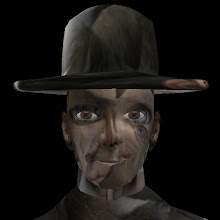It all started for me with David Hockney. I 'got' art because of him. The reason my alter-ego is called Cubist is because of Hockney. Most importantly, he lives in Bridlington, which is just up the road from where I live in Filey.
Last night's Hockney documentary on BBC1 reminded me why I'm in this game. More than anything, it is Hockney's attitude and approach that I aspire to. The ceaseless dedication to exploration. The blunt, non-nonsense Yorkshireness. The love of drawing. The fact that he does not let anyone or anything get in the way, not even his own previous declarations about what is right and wrong.
Enough of the fan-mail. The reason I'm writing this post is because I viewed last night's programme through the lens of postdigitalism. At one point, Hockney said something like, "This is art for the new post-photographic age", which obviously struck a chord with me. In my postdigital musings, I've referred to the predicted death of painting when photography was invented, and the conflict between these two media forms has been the focus of Hockney's most interesting work. The supposed supremacy of photography as the ultimate form of 'realism' is challenged when Hockney points out photography's limitations. Unlike futurism and, Hockney has argued, cubism and traditional painting, photography removes the time from an artwork. The time it takes to craft the work, the period of time the work represents - all but a hundredth of a second are eradicated from the photograph. Space and time are the same dimension, so traditional photography also removes the space, fixing the viewer to the spot. In real life, we never stop moving - "If your eyes stop moving, you're dead" as Hockney stated in the documentary - but the photograph freezes the world, whereas painting is about the continuum of space-time, with a living human being at its centre.
This recognition of the limitations of photography sometimes sees Hockney reject the photographic process altogether, but at other times it liberates him to use the camera more like a paint brush. The most obvious example of this is a Hockney's photo-collage 'joiner', with multiple perspectives via multiple photographs all collaged into one composition. Time and space return to the artwork, and the photographic medium is commandeered to serve the eye, heart and hand once more.
Might this tension between photography and painting in Hockney's work inform for the postdigital debate? The photograph and the digital have a lot in common. I'm not referring directly to digital photography here, but rather to the way that a snapshot captures and reduces the world to a small abstracted piece. It denies the continuum of life. It is one tiny part of the whole. Similarly, the digital captures and reduces the world into lots of tiny pieces. What is gained from this process of digitisation - the ability to make accurate copies, for example - drowns out the fundamental things that are lost. Identifying something fundamental that education loses in the digital, as Hockney identifies something fundamental that art loses in the photographic, may help us to form a coherent postdigital view. Just as the camera is liberated from the dogma of photography to serve art, so the computer may be liberated from the dogma of the digital to serve education.
Enough of this aspirational theorising. I have a degree course to re-write this year. How exactly will all of this postdigital stuff help me to write a better course? This will be real test. It's time for some convergent thinking.
Imagine (2009) David Hockney - A Bigger Picture. London, BBC1, 30 June.
Subscribe to:
Post Comments (Atom)

1 comment:
Hi Ian - I saw that documentary too. Really enjoyed it. Wasn't totally taken with the paintings themselves, but great to follow the (thought) processes...
Post a Comment